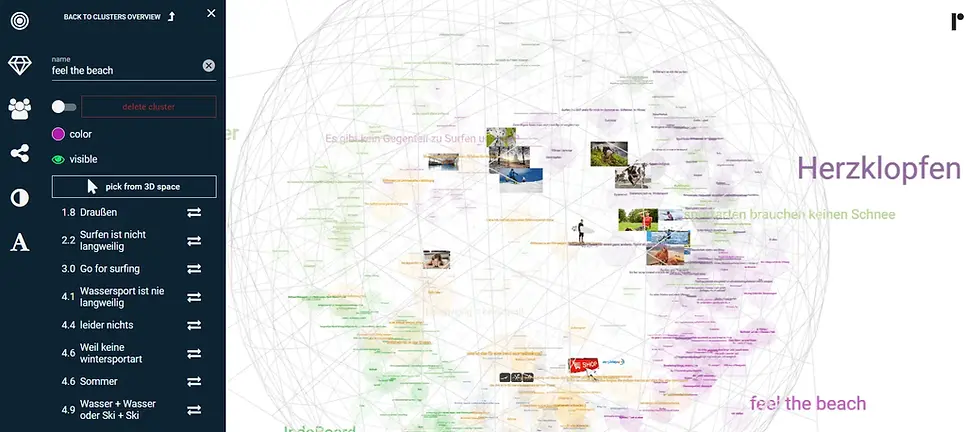Für alle, die tiefer in RepGrid einsteigen wollen
Die Anwendung von RepGrid ist methodisch anspruchsvoll – und gerade darin liegt seine Stärke. Wer mit RepGrid arbeitet, sollte sich nicht nur mit der Interviewtechnik, sondern auch mit der Analyse und Interpretation der Ergebnisse sorgfältig auseinandersetzen.
Wenn Sie RepGrid fundiert einsetzen möchten, empfehlen wir die vertiefende Lektüre ausgewählter Fachpublikationen unseres Inhabers Dr. Matthias Rosenberger, der sich seit über 25 Jahren intensiv mit den theoretischen, methodologischen und praktischen Aspekten der Repertory Grid Technik beschäftigt.
Dr. Matthias Rosenberger

"The more complex and dynamic a system is, the more important it becomes to cleverly combine resonance and differentiation capabilities to build meaningful relationships with customers and employees. Only in this way can you differentiate yourself from the competition, increase your distance from others, and remain accessible at the same time."
Why traditional questionnaires fail to reach people
The central problem with conventional survey methods – especially standardized questionnaires – lies in their theoretical bias: They primarily reflect the relevance systems of their developers, not those of the respondents themselves. While respondents answer the prescribed questions, it remains unclear whether the content is even meaningful to them. What gets lost in the process is the individual's frame of meaning – precisely what shapes human thought, decision-making, and action. repgrid reverses this principle: It starts with the people – and from there, uncovers what really matters.

repgrid – Recognizing complexity. Understanding people.
repgrid is a scientifically based diagnostic tool that reveals subjective attitudes where traditional surveys fail. As a digital evolution of George A. Kelly's Repertory Grid method, it reveals personal evaluation patterns that underlie human thought, decision-making, and action.
Because behavior doesn't emerge out of nowhere—it's shaped by deeply rooted beliefs and individual assessments, so-called insights. repgrid makes precisely these visible: It systematically collects personal perspectives, analyzes them in real time, and delivers clear, comparable results.
repgrid is a scientifically based diagnostic tool that reveals subjective attitudes where traditional surveys fail. As a digital evolution of George A. Kelly's Repertory Grid method, it reveals personal evaluation patterns that underlie human thought, decision-making, and action.
Because behavior doesn't emerge out of nowhere—it's shaped by deeply rooted beliefs and individual assessments, so-called insights. repgrid makes precisely these visible: It systematically collects personal perspectives, analyzes them in real time, and delivers clear, comparable results.
A specially developed mathematical procedure condenses the responses immediately after the survey – into a comprehensible overall picture, either individually or in group comparisons. The results are available immediately after the interview.
repgrid creates a strategic basis for well-founded decisions – in change processes, organizational development, marketing or product development.
A tool that reduces complexity – while putting people at the center.

George A. Kelly
Psychology of Personal Constructs
The repgrid has its origins in the theoretical and methodological ideas of the "Psychology of Personal Constructs" by George A. Kelly.
The "psychology of personal constructs" views people as researchers who, based on their experience, develop hypotheses for future situations, investigate them, confirm them, and adapt them if necessary.
To obtain an initial measurement approach for a person's subjective reality, Kelly developed the Role Construct Repertory Grid method in accordance with his basic theoretical assumptions. The basic methodology of the repgrid cannot be clearly classified as either a qualitative or quantitative measurement method. The repgrid allows for the advantages of qualitative interviews (depth of content) to be combined with the advantages of standardized questionnaires (true clarity).
The nature of the survey allows respondents to freely and almost unrestrictedly use their own descriptions to evaluate events or products (etc.), as in a qualitative interview. The results thus largely reflect the perspective of an individual, without external influence. Respondents thus create their own, highly personal questionnaire during the survey.
The relational assignment of elements of the individual's world of experience (events or objects) in a matrix, which results from the use of freely chosen constructs (description dimension), nevertheless allows inter-individual comparability through special mathematical and semantic analyses.
If a sufficient number of elements are used when surveying different respondents, individual patterns can be directly and quantitatively related to each other.

